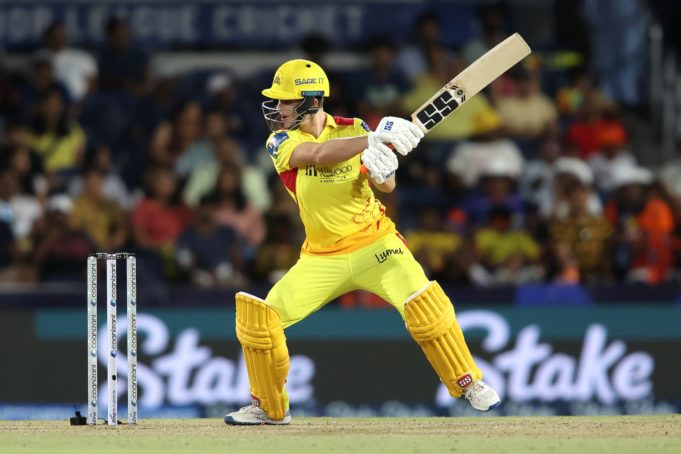Curtis Wilkerson, Cecil Espy, and Mark McLemore know about being versatile with a bat in their hands. All three switch-hit during their big league baseball careers, accumulating more than 11,000 combined Major League plate appearances. But when I handed them a bat at the end of some Q&A sessions I conducted with them this week, they all looked at it strangely.
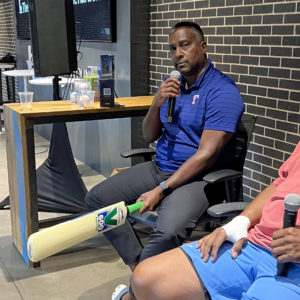 “Am I doing it right?” asked Wilkerson as he fiddled with it.
“Am I doing it right?” asked Wilkerson as he fiddled with it.
The bat I’d handed them wasn’t the kind they were used to.
“It’s different than a (baseball) bat, that’s for sure,” said McLemore.
“This is a thicker mass,” noted Espy. “It’s just flat.”
The implement I’d had them inspect was a cricket bat.
Major League Cricket, that sport’s top U.S. league, is staging matches this week in Grand Prairie. I happened to also be spending Tuesday and Wednesday emceeing at Globe Life Field in Arlington, as former Rangers coached up employees and clients of The Hartford on the field and provided baseball insights in a question-and-answer session. That confluence made me curious about how men who had played at the highest levels of one bat and ball sport would react to the presence of another game with at least superficial similarities to their own.
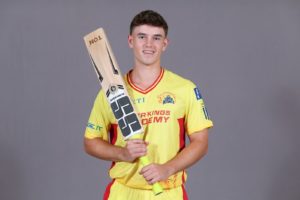
I also spoke with Joshua Tromp Tuesday before his Texas Super Kings took on the LA Knight Riders. The cricketer hails from South Africa, but his family moved to the U.S. three years ago. The relocation set him up to get some exposure to what his new country has historically called its “national pastime.”
“I’ve been to a couple of baseball games living in Austin, Texas,” the 20-year-old all-rounder, who both bowls and bats, said. “I’d go watch a couple of the (University of Texas) Longhorns games. And, yeah, I think the skillset is pretty similar where hitting and throwing is.”
My guess is that if baseball players found themselves living in a cricket-playing country like South Africa, India, or the UK, they’d get curious enough to check out a match. One of The Hartford’s attendees, a Brit named Keith, told me he had grown up as a supporter of the Surrey County Cricket Club and become a fan of San Francisco’s baseball franchise once he moved to the States. Tromp found himself developing an allegiance for the Giants’ rival by virtue of his own relocation.
“One of my good friends back in Austin is a massive (Los Angeles) Dodgers fan. So I hear all the time about how good Shohei Ohtani is and all these other guys,” he said. “Being around him kind of urged me to go get a Dodgers hat. I like the style of the hat, so I kind of wear that hat everywhere I go now.”
Developing affinity for a game with similarities to one you already liked is easier when you’re surrounded by it and its biggest games are played in accessible time zones. The reverse – creating a fanbase for a sport in a new country – is tougher to pull off.
MLB has worked for years to cultivate an international presence. I had a family friend who coached for years in Austria and we’ve now gotten to the point where the league has staged regular-season contests in other nations. Major League Cricket is the lead horse for its sport in trying to build an identity in the U.S. Having high-level games available is an important step.
“Every time I see (baseball) on TV, I’ll switch it on and have a watch. Hopefully some of the baseball fans will do the same in the future with cricket,” said Tromp.
The MLC games are available stateside on Willow TV. Espy did comment that he’d watched a little bit of the sport on television. Tromp hopes it will eventually grow to the point where larger U.S. media outlets find the audience compelling enough to broadcast matches. He did get some exposure hitting for a media outlet with sizable online reach.
“We played a game with Jomboy Media where they did a mixture of cricket and baseball,” he said of The Warehouse Games hybrid played in an indoor space with baseball bats and cricket-style run scoring. He had to adjust to hitting with the different style of bat, but acquitted himself well, had fun, and developed an appreciation for the relative difficulty of, as McLemore put it, “hitting a round ball with a round bat that’s moving.”
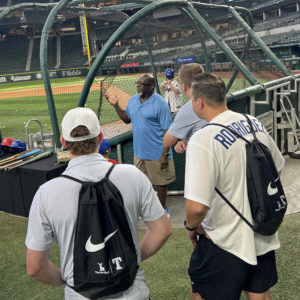 The former Major Leaguers expressed healthy respect for the challenges that might come with trying to adjust to a new game.
The former Major Leaguers expressed healthy respect for the challenges that might come with trying to adjust to a new game.
“Good thing pitchers don’t hit any more. That’s my thought,” said MLB All-Star and Fort Worth native Yovani Gallardo of the cricket bat he was holding. “I can see 0-for-3 with three strikeouts in my future with that one.”
Gallardo might sell himself short. As a Silver Slugger winner and one of the best hitting pitchers of his era, I’d draft him early if I were putting together a Warehouse Games team, even with cricket bats. The other two pitchers in our sessions, Darren Oliver and José Guzmán, both threw great curveballs off a mound. Perhaps they’d have achieved success as spin bowlers.
We had a number of children in attendance with their parents at both the cricket match and the baseball play day. Living in North Texas, they’ve always had the option to play baseball. Their opportunities to try cricket are growing.
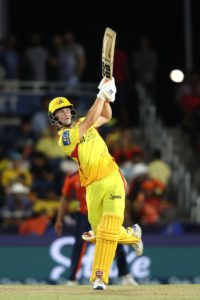
“I grew up in in a sport family. My dad got me into golf, tennis, cricket, (field) hockey, rugby. I played a variety of different sports. I used to play tennis at quite a high level in South Africa,” said Tromp, who eventually decided individual sports slightly lagged the one he’s now pursuing professionally.
“I enjoyed being in a team, playing with teammates, just the team camaraderie and that’s what kind of drew me to cricket and made me want to become a cricket player.”
McLemore talked about playing football in high school (the American code). Darren OIiver said he engaged in bowling (the one with pins, not wickets) as an adult thanks to a kegler teammate named John Burkett. When it comes to finding a sport one can play and enjoy, perhaps into adulthood and even professionally, the more options the better.



